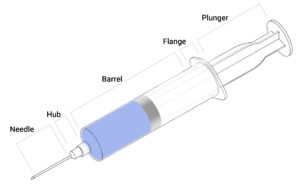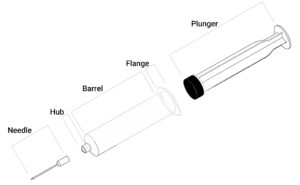The diagram below is of a simple syringe with common parts labeled and descriptions of a part’s function.

Syringe Parts Name & Function
- Needle – metal, Teflon, or plastic that pierces target
- Hub – metal or plastic that connects needle to the barrel of the syringe
- Barrel – graduated cylinder that holds liquid for infusion
- Flange – finger support and stopper for plunger
- Plunger – mechanism that seals fluid inside barrel
Why Researchers Should Consider Each Component
- Syringes allow for administering accurate volumes of fluid
- Elements of a syringe must be compatible to ensure accuracy
- Keeps the syringe user, fluid, and infusion target safe

Needle
The needle or tubing system connected to the tip/termination of the syringe can often restrict the flow of the fluid which may cause enough back pressure to result in the syringe pump stalling. To minimize the amount of back pressure, a larger inner diameter and/or shorter length tubing should be utilized when possible.
Hub
The hub is a metal or plastic base of the needle that connects the barrel to the needle for infusion or injection.
Barrel
It is a cylindrical chamber that holds the liquid to be injected or withdrawn and where you can find the graduation. It is transparent so that the content can be visible; however, in some instances, an opaque barrel is required for light-sensitive applications. The barrel forms the body of a syringe that houses the plunger. Syringes can vary in size depending on how much fluid is required. Graduation line volumes can vary on the syringe and can be in milliliters (mL) or microliters (µL), depending on how big the syringe is. For accuracy and precision, the smallest dispensing volume for a given syringe should be greater than or equal to 10% of its total capacity. (i.e. A 10 µL syringe is capable of transferring the smallest volume of 1 µL.)
Barrel Features
Outer diameter
- The outer diameter (OD) represents the thickness of the syringe barrel. This value determines whether the syringe will physically fit on the syringe pump. Most syringe pump manufacturers indicate the allowable syringe dimensions for a syringe pump by the volume of the syringe. This approach often works because most syringes of a certain volume have a similar OD, but the OD of some specialty syringes (tapered, gastight, steel, etc.) are drastically different from their more common counterparts. Applications can be performed more accurately knowing the OD of a syringe and the maximum OD allowed by a syringe pump. Some syringes may have uneven or tapered barrels causing the syringe to not lie horizontally in the syringe block holder. If the plunger is not horizontal and the syringe plunger cap is not flush against the pusher block, then that results in the pusher block pushing horizontally against a non-horizontal plunger. This can cause inaccurate flow rates and potential damage to any syringe type.
Inner diameter
- The inner diameter (ID) represents the thickness of the cavity inside the barrel where the fluid is stored. This value is extremely important because it needs to be known to be able to set accurate flow rates on the syringe pump. The flow rate of a syringe pump is based on the linear distance the syringe plunger needs to travel to transfer a specific volume in a set amount of time. Because the inner cavity of the syringe barrel is a cylinder, the linear distance the plunger needs to travel can be determined based on the volume equation for a cylinder. The following represents the cylinder volume equation that has been rearranged to calculate the linear distance the plunger travels to transfer a specific volume.
Volume
- The syringe volume should have enough volume to satisfy the user’s application. However, the user should be careful to select a syringe that does not excessively exceed their volume requirements. Syringes have approximately an 1% error in volume for glass syringes (about 5% error for plastic syringes). This means that users should select the smallest syringe possible for their application that allows. For example, using a 50-mL syringe to transfer 1 mL of fluid would have about a 0.5 mL error in volume, which would be problematic because the actual volume dispensed could range from 0.5 to 1.5 mL.
l = V / πd/202 where l is the linear distance the plunger travels in cm, V is the volume in mL, and d is the diameter in mm.
Flange
The size of the flange is important for the stability of the syringe on the syringe pump. The flange should be large enough that when it is pressed against the syringe holder block, it will help prevent the syringe from moving forward when the plunger is being pushed. On syringe pumps that can withdraw, the flange should be large enough that the flange bracket can clamp on to it.
Plunger
The inner part of the syringe is called the plunger. It is the thing that moves freely up and down inside the barrel, creating a vacuum to draw liquid in or push it out through the tip. Some syringes have interchangeable barrels and plungers, extending their performance and increasing cost-effectiveness.
Syringe Material
The type of material used for the syringe can have an effect on the user’s application as well as the use of the syringe infusion pump and its accessories.
Plastic
- Plastic syringes are an inexpensive, disposable option that typically comes sterile out of the box. Typically, these syringes come with either a full plastic plunger tip or a rubber plunger tip. The rubber plunger syringe tip type is the better option to minimize fluids leaking past the plunger. However, plastic syringes do have a couple of significant drawbacks. Plastic syringe plungers and barrels have some flex under pressure which leads to volume inaccuracies as high as 5%. Additionally, rubber-tipped plungers tend to absorb some organic solvents such as DMSO.
Glass
- Glass syringes are used as the most common type of syringe for syringe pumps. Glass syringes are reusable, compatible with most applications, and more accurate than most syringe types. The plunger of a glass syringe can be made of ground glass, glass with a Teflon syringe tip type, metal-only, or metal with a Teflon tip. A ground glass plunger is typically the cheapest option, but it can suffer from leakage of fluid past the plunger leading to volume inaccuracies. Additionally, some chemicals may cause the ground glass to fuse rendering the syringe useless. The other types of syringe plungers lead to syringes that are the most accurate with minimal leakage (some are even air-tight). The decision to use one type over the other depends on the compatibility of the fluid with the syringe plunger type. The biggest downside for these syringes is the cost, which is significantly greater than most syringes.
Stainless Steel
- Stainless steel syringes are the most durable syringes available. These syringes are primarily used for high-pressure dosing applications that would cause a glass or plastic syringe to burst. While having an accuracy similar to glass syringes, they do not typically come in sizes much smaller than 5 mL, which minimizes their application for smaller scale use. Stainless steel syringes are more expensive and are not transparent, which can make loading and removing air bubbles more challenging.



